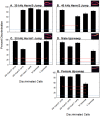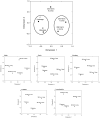Discrimination of ultrasonic vocalizations by CBA/CaJ mice (Mus musculus) is related to spectrotemporal dissimilarity of vocalizations
- PMID: 24416405
- PMCID: PMC3887032
- DOI: 10.1371/journal.pone.0085405
Discrimination of ultrasonic vocalizations by CBA/CaJ mice (Mus musculus) is related to spectrotemporal dissimilarity of vocalizations
Abstract
The function of ultrasonic vocalizations (USVs) produced by mice (Mus musculus) is a topic of broad interest to many researchers. These USVs differ widely in spectrotemporal characteristics, suggesting different categories of vocalizations, although this has never been behaviorally demonstrated. Although electrophysiological studies indicate that neurons can discriminate among vocalizations at the level of the auditory midbrain, perceptual acuity for vocalizations has yet to be determined. Here, we trained CBA/CaJ mice using operant conditioning to discriminate between different vocalizations and between a spectrotemporally modified vocalization and its original version. Mice were able to discriminate between vocalization types and between manipulated vocalizations, with performance negatively correlating with spectrotemporal similarity. That is, discrimination performance was higher for dissimilar vocalizations and much lower for similar vocalizations. The behavioral data match previous neurophysiological results in the inferior colliculus (IC), using the same stimuli. These findings suggest that the different vocalizations could carry different meanings for the mice. Furthermore, the finding that behavioral discrimination matched neural discrimination in the IC suggests that the IC plays an important role in the perceptual discrimination of vocalizations.
Conflict of interest statement
Figures





Similar articles
-
Efficient encoding of vocalizations in the auditory midbrain.J Neurosci. 2010 Jan 20;30(3):802-19. doi: 10.1523/JNEUROSCI.1964-09.2010. J Neurosci. 2010. PMID: 20089889 Free PMC article.
-
Frequency difference limens and auditory cue trading in CBA/CaJ mice (Mus musculus).Behav Processes. 2014 Jul;106:74-6. doi: 10.1016/j.beproc.2014.04.016. Epub 2014 May 5. Behav Processes. 2014. PMID: 24811450 Free PMC article.
-
The effects of aging and sex on detection of ultrasonic vocalizations by adult CBA/CaJ mice (Mus musculus).Hear Res. 2016 Nov;341:119-129. doi: 10.1016/j.heares.2016.08.014. Epub 2016 Aug 27. Hear Res. 2016. PMID: 27579993 Free PMC article.
-
Coding of communication calls in the subcortical and cortical structures of the auditory system.Physiol Res. 2008;57 Suppl 3:S149-S159. doi: 10.33549/physiolres.931608. Epub 2008 May 13. Physiol Res. 2008. PMID: 18481905 Review.
-
Serotonin in the inferior colliculus.Hear Res. 2002 Jun;168(1-2):1-11. doi: 10.1016/s0378-5955(02)00365-9. Hear Res. 2002. PMID: 12117504 Review.
Cited by
-
The perception of ultrasonic vocalizations by laboratory mice following intense noise exposures.J Acoust Soc Am. 2024 Feb 1;155(2):867-878. doi: 10.1121/10.0024614. J Acoust Soc Am. 2024. PMID: 38310604 Free PMC article.
-
Primed to vocalize: Wild-derived male house mice increase vocalization rate and diversity after a previous encounter with a female.PLoS One. 2020 Dec 9;15(12):e0242959. doi: 10.1371/journal.pone.0242959. eCollection 2020. PLoS One. 2020. PMID: 33296411 Free PMC article.
-
The temporal organization of mouse ultrasonic vocalizations.PLoS One. 2018 Oct 30;13(10):e0199929. doi: 10.1371/journal.pone.0199929. eCollection 2018. PLoS One. 2018. PMID: 30376572 Free PMC article.
-
Discrimination of frequency modulated sweeps by mice.J Acoust Soc Am. 2016 Sep;140(3):1481. doi: 10.1121/1.4962223. J Acoust Soc Am. 2016. PMID: 27914389 Free PMC article.
-
High-precision spatial localization of mouse vocalizations during social interaction.Sci Rep. 2017 Jun 7;7(1):3017. doi: 10.1038/s41598-017-02954-z. Sci Rep. 2017. PMID: 28592832 Free PMC article.
References
-
- Searcy WA, Nowicki S (2005) The evolution of animal communication. Princeton, NJ: Princeton University Press.
-
- Seyfarth RM, Cheney DL, Marler P (1980) Vervet monkey alarm calls: semantic communication in a free-ranging primate. Anim Behav 28: 1070–1094.
-
- Portfors CV (2007) Types and functions of ultrasonic vocalizations in laboratory rats and mice. J Am Assoc Lab Anim Sci 46: 28–34. - PubMed
Publication types
MeSH terms
Grants and funding
LinkOut - more resources
Full Text Sources
Other Literature Sources

